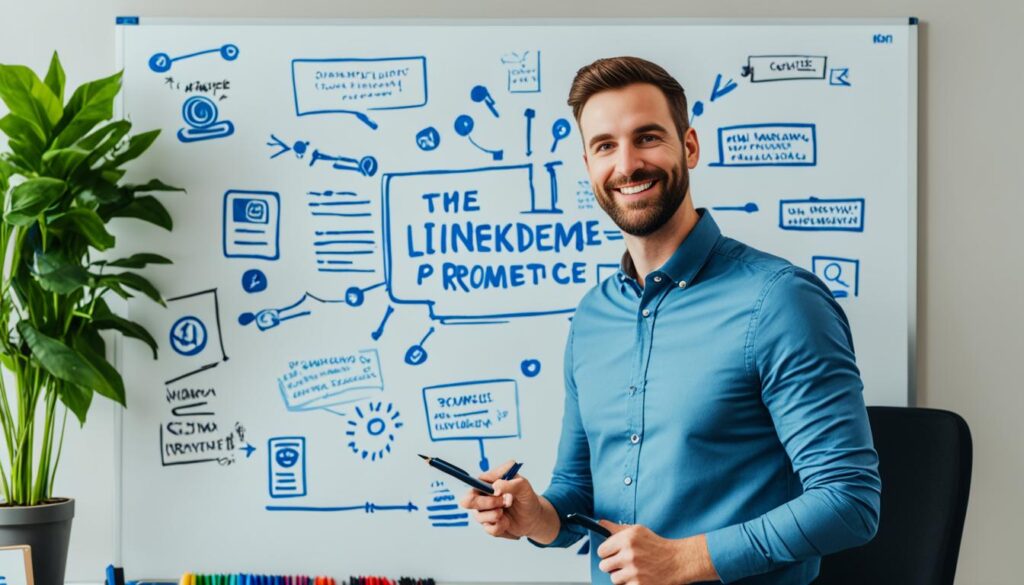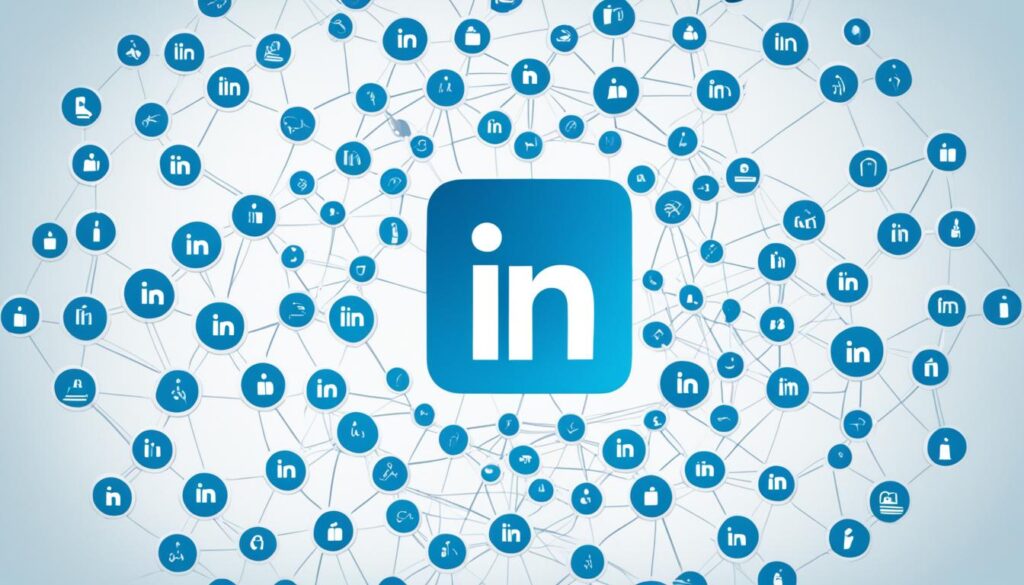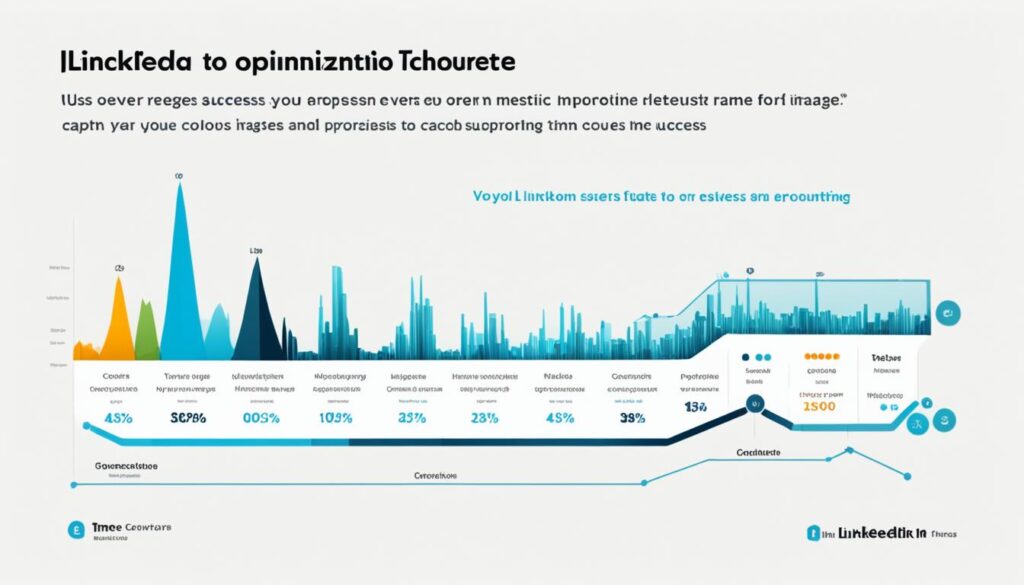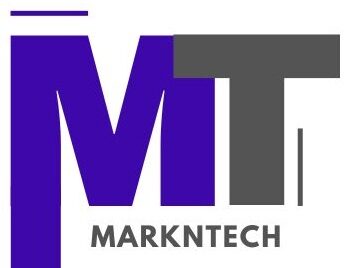In today’s digital world, virtual sales development reps (SDRs) face a big challenge. They must master the art of LinkedIn messaging. I often get asked, What’s the secret to making LinkedIn messages that grab attention and spark real engagement?
The key is mixing personal touches, valuable content, and building real connections. We’ll look at top tips for improving your LinkedIn outreach. We’ll help virtual SDRs succeed in the changing world of B2B lead generation messaging.
Key Takeaways:
- LinkedIn is a key tool for B2B lead generation, 277% more effective than other social media.
- Personal touches are key for success, as generic messages often get ignored.
- Great subject lines, valuable content, and a professional tone are vital for engaging your audience.
- Using LinkedIn features like voice messages and videos can help you stand out and build stronger connections.
- It’s important to keep track of and improve your outreach strategies for long-term success.
Introduction
As a sales development representative (SDR), making good LinkedIn messages is key. It helps you get more people to respond. LinkedIn is a big tool for B2B salespeople today. But, you must use it right.
Importance of Effective Messaging for SDRs
Bad messages don’t work well on LinkedIn. They don’t connect with people. To do well, build real relationships, offer value, and skip the hard sell. Making messages that grab your prospects’ attention is key for SDRs who want to get results.
Overview of Key Strategies
This article will show you 10 ways to make LinkedIn messages that get people engaged and convert. You’ll learn how to make your messages stand out and get people to act.
Mastering LinkedIn messaging can make your sales work better. It can also get more people to respond. This means more leads and sales for your company. Let’s look at the strategies to help you do well at LinkedIn outreach.
1. Personalize Your Message
For virtual SDRs, making LinkedIn messages personal is key. Tailoring your outreach to each person helps you connect better. This increases the chance of getting a meaningful reply. Here are three ways to make your LinkedIn messages more personal:
Using the Recipient’s Name
Using the person’s name in your message is a strong move. It shows you know who they are and care. This makes your message feel more personal and interesting.
Referencing Mutual Connections or Interests
Talking about shared connections or interests can help you connect better. Mentioning mutual friends or specific things you know about them makes your message stand out. It shows you’ve done your homework.
Customizing Content Based on Their Profile
Look at the person’s LinkedIn profile for details to use in your message. This could be their job, industry, or what they’re facing. Tailoring your message to their needs shows you care about their situation.
Using these tips can make your LinkedIn messages more engaging and relevant. This helps virtual SDRs build strong connections and get better lead generation results.

“Personalization is the key to effective LinkedIn messaging. By taking the time to understand your prospects and craft tailored outreach, you can significantly improve your engagement and conversion rates.”
– Naseef KPO, B2B Marketing Strategist at Skalegrow
2. Craft a Compelling Subject Line
When you message prospects on LinkedIn, your subject line is key. It’s the first thing they notice. It can help or hurt your chances of getting a reply. Here are tips to make a great subject line:
Keeping It Short and Relevant
LinkedIn lets you use up to 200 characters for your subject line. But, it’s smart to keep it short and clear. Try to keep it under 50 characters. Messages with shorter subject lines are 50% more likely to get a.
Creating Curiosity
Your subject line should grab the reader’s attention. Use language that makes them curious. Ask a question or hint at a valuable tip you have.
Avoiding Clickbait Tactics
Creating curiosity is good, but don’t use clickbait-style subject lines that seem spammy. Keep your tone professional and honest to gain trust with your prospects.
Making a great subject line takes practice. Focus on being relevant, brief, and real. This can greatly improve your LinkedIn messaging and boost the chances of your personalized LinkedIn messages being opened and read.
“The subject line is the first thing a prospect sees, so it needs to be compelling and relevant.”
3. Be Clear and Concise
When you write LinkedIn messages for sales, make them clear and to the point. People don’t have much time or focus, so you need to quickly share your main idea. This helps catch their interest and get them to respond.
Getting to the Point Quickly
Don’t waste time with long introductions. Start by saying what you want and how you can help. This grabs their attention and shows the value you offer.
Using Simple and Direct Language
Avoid hard words or jargon. Use simple words that are easy to get. This makes your message more fun to read and shows you can talk clearly.
Avoiding Jargon and Complex Terms
Don’t use special words or hard terms that people might not know. Keep your words easy and focus on the good things you can do. This shows you’re all about helping, not just showing off.
| Effective Messaging | Ineffective Messaging |
|---|---|
| Let’s explore how our lead generation services can help you get more customers. | Our cutting-edge B2B lead acquisition platform uses AI to find top prospects. |
| I saw your posts about growing your company. I have some ideas to help you reach your goals faster. | As an expert in sales strategies, I’d love to share some tips with you. |
Keep your LinkedIn messages clear, short, and simple. This way, your b2b lead generation messaging will connect better with your prospects. Aim to add value and show your skills in a way that’s easy to understand.
4. Highlight Value Proposition
When making LinkedIn messages for your SDRs, focus on what makes you special. Don’t just list features. Talk about how your product or service can solve their problems.
Explaining How You Can Help Them
Clearly explain the benefits your solution offers. Use simple language to show how it can make things easier or better for them. Use LinkedIn Sales Navigator to learn about their industry and tailor your message.
Showcasing Benefits Over Features
Don’t just list features. Focus on the main benefits that will matter to your prospect. Show how your solution can solve their problems or help them reach their goals.
Using Relevant Case Studies or Testimonials
Include case studies or customer testimonials to support your message. These examples can make your claims more believable. They show how your solution has helped businesses like theirs. By showcasing credibility, you build trust and increase the chance of a positive response.
| Key Statistics | Value |
|---|---|
| Minimum target for founder-led sales efforts | $100K in ARR or more |
| LinkedIn Sales Navigator additional features | Beyond the free LinkedIn version |
| Advanced search filters in Sales Navigator | Location, industry, job title, company size |
| InMail feature in Sales Navigator | Send direct messages to prospects, even if not connected |

“Craft personalized InMail messages to resonate with prospects by referencing their industry, recent achievements, or shared connections.”
By focusing on the value proposition, crafting effective LinkedIn messaging, and leveraging Outbound SDR strategies, your virtual SDR team can improve their b2b lead generation messaging. This can lead to better results for your business.
5. Provide a Clear Call to Action
When writing your LinkedIn messages, make sure to include a clear call to action. This tells the prospect what you want them to do next. It makes the conversation move forward and increases the chance of a good response. By making it easy for them, you can make your outreach more effective and increase your chances of success at scale.
Being Specific About Next Steps
Don’t use vague CTAs like “Let me know if you’re interested” or “Feel free to reach out.” Instead, be clear and direct. For example:
- Would you be available for a 15-minute call this week to discuss how we can help you [insert relevant benefit]?
- I’d be happy to send over some additional information about our [product/service]. Would you prefer a PDF or a short video overview?
- When would be a good time for us to connect and explore how we can [insert relevant benefit] for your team?
Making It Easy for Them to Respond
Make it easy for the prospect to take the next step. Offer different ways to contact you, like a link to schedule a call, your email, or your phone number. This makes the process smoother and increases the chance they will respond.
Including Multiple Contact Options
Give the prospect several ways to get in touch, such as:
- Click here to schedule a 15-minute call: [link to calendar booking tool]
- Feel free to email me directly at [your email address]
- You can also reach me at [your phone number]
By being clear and making it easy to respond, you can make your outreach more effective. This increases your chances of getting more responses on LinkedIn.
6. Follow Up Thoughtfully
LinkedIn prospecting is more than just the first message. It’s about building a relationship through thoughtful follow-ups. As an SDR, it’s key to time your messages well, add value, and be persistent but not pushy. This approach helps in engaging prospects and increasing sales.
Timing Your Follow-Ups Appropriately
Getting the timing right for follow-ups is crucial. You don’t want to spam prospects, but you also can’t let the conversation die. It often takes several interactions to build trust and move a prospect to buy.
Using automated cadence management tools helps you follow up at the right time. This keeps you in their mind without being annoying.
Adding Value in Follow-Up Messages
Every follow-up should give the prospect real value. This could be sharing industry news, offering helpful tips, or sending personalized content. By showing you know your stuff and care about their success, you build stronger connections. You become a trusted advisor, not just a salesperson.
Being Persistent Without Being Pushy
Being persistent is important for engaging prospects, but be careful how you do it. Don’t keep sending the same pitch over and over or asking for their time. Instead, focus on adding value, meeting their needs, and letting them decide when to talk more.
Respecting their space and building trust can lead to real engagement and sales.

Thoughtful follow-ups are key to doing well on LinkedIn and engaging prospects. By timing your messages, adding value, and being persistent but respectful, you can build relationships, gain trust, and get better results for your sales team.
7. Use LinkedIn Features Effectively
As a smart sales development representative (SDR), you know LinkedIn is key for outreach and building connections. To make a big impact, use LinkedIn’s many features. Tools like voice messages, videos, and analytics can help you stand out and connect deeply with people.
Leveraging Voice Messages and Videos
Using audio and visuals in your LinkedIn outreach can make you stand out. Recent data suggests many haven’t tried audio or video messages on LinkedIn. A short voice message or video can grab your prospects’ attention and show you’re interested in connecting.
Utilizing LinkedIn Analytics Tools
LinkedIn’s analytics tools give you key insights to improve your outreach. These features let you see how your messages perform, understand who’s engaging with you, and find the best ways to connect with prospects. With this info, you can keep making your LinkedIn outreach better and more relevant.
Engaging with Their Content Before Messaging
Connecting with your prospects on LinkedIn is key. One good way is by interacting with their posts before you message them. Making thoughtful comments, shares, and likes shows you care about their work and industry. This can make your later messages more meaningful and effective.

“Using LinkedIn features like voice messages, videos, and analytics can make your outreach more personal and effective. Also, interacting with their posts before messaging helps build a connection and shows you’re interested in their success.”
8. Measure and Optimize Your Outreach
To make your outreach better, track important metrics like response rates and engagement. This info helps you improve your LinkedIn messaging strategy. It also shows you the best ways to get more responses from your audience.
Tracking Response Rates and Feedback
Keep an eye on how many people respond to you and what they say. This tells you what messages work well and where you can get better. By looking at the data, you can make smart changes to your outreach.
A/B Testing Different Approaches
Testing your LinkedIn messages with A/B testing is a great way to get better. Try out different subject lines and content to see what people like more. This helps you find the best way to talk to your audience and get better results.
Continuously Improving Your Messaging
Improving your LinkedIn messaging is a never-ending task. Always check how well your outreach is doing, ask for feedback, and tweak your approach. This way, you’ll find the best ways to connect with your audience and get the results you want.

“Regularly refining your outreach strategies is necessary to stay competitive and achieve your set goals.”
9. Showcase Credibility and Expertise
It’s key to build trust on LinkedIn by showing you’re credible and an expert. Share your big wins and skills, like testimonials or endorsements. Show you know a lot about your prospect’s field to be seen as a trusted advisor.
Highlighting Relevant Achievements and Skills
Your LinkedIn profile should show off your big wins and skills. Talk about awards, certifications, or other big moments that prove your expertise. Make sure to point out skills that match what your prospects need.
Including Testimonials or Endorsements
Using good words from past clients or peers can boost your trust level. These social proofs show others have gotten value from you and trust your skills.
Demonstrating Knowledge of Their Industry
Show you get the unique issues and trends in their field. Mention industry news, data, or insights to prove you’re up to speed. This makes you a valuable partner, not just another salesperson.
By always showing your credibility, skills, and industry smarts, you become a trusted advisor. This boosts your chances of making real connections and getting better responses on LinkedIn.
10. Maintain a Professional and Respectful Tone
When you write your LinkedIn messages, keep a professional and respectful tone. This builds trust with your prospects and makes your messages more likely to get a reply.
Keeping Messages Polite and Professional
Always use polite and professional language. Don’t use too casual or rude language. Your messages should show you respect your prospects and their time.
Respecting Their Time and Privacy
Be mindful of how many messages you send and how often you reach out. Timing your follow-ups right and adding value in each message is key to keeping a professional relationship.
Avoiding Overly Familiar Language
Personalize your messages but don’t be too familiar. Don’t assume you know what your prospect likes or their personal life. Keep your messages focused on the professional side and how you can help them.
By always using a professional and respectful tone in your LinkedIn messages, you can build better relationships with your prospects. This helps you engage more with prospects and boosts your response rates. Remember, being professional and thoughtful is crucial for successful SDR outreach online.
Conclusion
Creating effective LinkedIn messages for virtual SDRs needs a strategic plan. This plan should focus on making messages personal, adding value, and keeping a professional tone. By using the tips in this article, SDRs can make their LinkedIn messages more engaging. This helps them build relationships and get more leads and sales.
Success in LinkedIn messaging comes from personalizing messages, using strong subject lines, and clear language. It’s also key to show the value you offer and give a clear call to action. Using LinkedIn’s tools, checking your results, showing you know your stuff, and staying professional helps get more replies and boost sales.
LinkedIn messaging and virtual selling are always changing. So, it’s important for SDRs to keep up with new tips and adjust their plans. By using these strategies and always improving, virtual SDRs can become trusted advisors. They can build strong connections with their prospects and achieve better sales results.
FAQ
How effective is LinkedIn for B2B lead generation?
What are the key challenges with LinkedIn prospecting?
Why is personalization crucial for effective LinkedIn messaging?
What makes a compelling LinkedIn subject line?
How should LinkedIn messages be structured for maximum impact?
What is the importance of follow-up in LinkedIn outreach?
How can LinkedIn features be leveraged to enhance outreach?
How can SDRs continuously improve their LinkedIn messaging?
Why is establishing credibility and expertise important for LinkedIn outreach?
How should the tone be maintained in LinkedIn messages?
Source Links
- How to write LinkedIn prospecting messages [28 templates]
- 7 DIY tips for SDRs to build an effective Linkedin content strategy
- 16 LinkedIn Message Templates That Don’t Scream “Prospecting” | Mixmax
- SDR Thoughts: The Role of LinkedIn in the SDR position
- Maximising LinkedIn for social selling: a comprehensive guide for SDRs
- An Introduction to LinkedIn Social Selling | Sellerate
- What are the best ways to personalize your messaging across channels and platforms?
- How do you personalize sales messages?
- LinkedIn Outreach – 7 Ways To Optimize It Using Personalization – Skalegrow
- 10 LinkedIn Sales Message Templates [Conversation Starters] | Skylead
- 8 LinkedIn Messaging Templates for Sales That Get Responses
- Best LinkedIn Sales Message Templates for More Sales – Clevenio
- How SDRs lose a prospect, and how to avoid it
- The untapped potential of LinkedIn voice messages
- Daniel Wiener on LinkedIn: #persona #emailpersonalization #coldemail #ai #sdr #ae #outboundsales | 22 comments
- Founder’s guide to SDR: mastering founder-led sales with LinkedIn Sales Navigator
- Sally Duby on LinkedIn: Modern Sales Resources (AE, SDR & CSM roles) | 29 comments
- How can Outbound SDR and Account-Based Sales help you scale your Global Sales?
- Chuck Moxley on LinkedIn: Here's my second suggested resolution for SDRs/BDRs and AE's prospecting…
- Creating An Effective SDR Program: A Strategy For Startup Growth
- 18 LinkedIn recruiter message templates to 2x candidates’ responses – Expandi
- Cultivating Deeper Connections with Your Prospects: A Guide for SDRs in the Outbound Context
- – The GTM with Clay Blog
- How SDR’s Can Build MORE Pipeline on LinkedIn
- Turning Smart SDR’s Into High Performers
- LinkedIn Prospecting Messages: How to Nail One [+ Templates]
- 9 Ways To Improve SDR Productivity
- Mastering the Art of Personalized Outreach: How to Use Chat GPT Correctly as a Sales Development Representative
- How To Measure And Optimise Your Email Outreach
- Kendra Lee on LinkedIn: 9 Little-Known Ways to Find New Prospects on LinkedIn
- How to Write a Professional LinkedIn Headline [+ 20 Inspiring Examples]
- Introducing a new Focused Inbox, internal mobility opportunities, skills certifications & more + Inspiring conversations about how to get things done
- The Ultimate Guide for Managing Remote SDRs
- 9 Tips To Improve Your LinkedIn InMail Response Rate
- Kevin Jarvis on LinkedIn: #sdr #accountexecutive #brokensalesprocess | 122 comments
- Sales Development Revolution | Episode #6 | SDRevolution
- AI for SDRs: Everything You Need to Know
- A Guide on How to Build a High-Performing Virtual SDR Team
